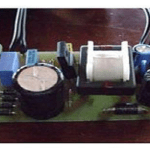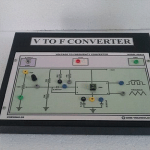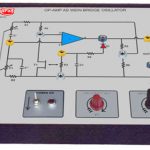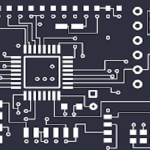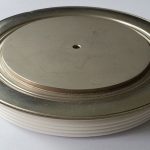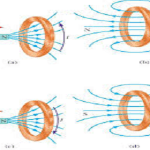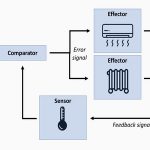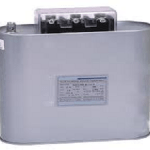In the domain of electronics, we know that a regulator is a type of device or apparatus that can control the level of output power. There are many kinds of regulators available in the market which depends on the supply of power. But primarily, in the conversion process of DC to DC, there are mainly two kinds of regulators which are Linear and Switching. A linear type of regulator adjusts the output through a resistive voltage drop. With this, efficiency decrement and also power loss in the form … [Read more...]
What is a Voltage Follower : Circuit & Its Working
We all know that an operational amplifier is the analog type of circuit that considers differential voltage as input and provides a single-ended voltage as output. These op-amps are mainly employed in the voltage follower circuits. But the arrangement of the op-amp in the voltage follower imposes high risk and capacitive stacking of oscillations. These huge loads show more impact on the operational amplifier stability dependent applications. So, let us know how the arrangement can be done in a … [Read more...]
Wien Bridge Oscillator : Circuit Diagram & Its Operation
The electronic circuits used to generate periodic, oscillating signals such as sine waves or square wave,s or triangular wave are known as Oscillators. Oscillators take a DC signal and convert them into the required AC signal. These are used in numerous electronic devices where a clock signal is required. Some of the applications of oscillators are clock generators in calculators, computers, digital clocks, video games, etc... The signals generated by oscillators are also used in radio … [Read more...]
What is Synchroscope : Circuit & Its Working
In electrical power systems, a device is needed to measure the angle between any two AC systems like power networks or generators, which are synchronized with each other. To synchronize any two electrical systems, they must be operating at the same frequency at a phase angle of zero degrees. The synchroscope devices are used to measure the frequency and phase angle differences between two AC systems. If these differences are zero, then the two systems can be connected and synchronized with each … [Read more...]
What is EasyEDA : PCB Designing & Circuit Simulation
Before clearly knowing about the tool EasyEDA, let us first understand why this tool is required and how it saves cost and time in the domain of electrical engineering. People who work in the professions of the embedded engineer, electrical engineer, and electrical tester, have to design circuits, create boards and simulate the boards in an easier and simpler approach. So, EasyEDA is the online tool that crucially helps in the design of circuits. The initial version of this tool was appeared in … [Read more...]
What is Gate Turnoff Thyristor & Its Working
"Thyristor" is a semiconductor device that is popularly used as a switch in power circuits. With alternating layers of P-type and N-type materials, the thyristor is designed as a four-layered structure. It is available as both two-lead and three-lead designs. The three-lead design of the thyristor consists of an anode, a cathode, and a Gate lead. The thyristor usually starts conducting when the gate lead is triggered with the current and once turned ON, the thyristor conducts continuously until … [Read more...]
What is Lenz’s Law : Formula, Significance & Its Uses
Lenz’s law was initially proposed by Heinrich Friedrich Lenz where his entire career was completely contributed to physics and chemistry. His initial observation was on the Peltier effect which means metals conductivity nature and change in the value of electrical resistance in correspondence to temperature. Then the research of Lenz moved to electrical conductivity and discovered the Joule effect which was the study regarding electrical variations independence were directed to the announcement … [Read more...]
What is a Virtual LAN : Architecture & Its Types
These days, the communication network has been implemented with the growing technology. The communication between the computer networks is achieved very easily by dividing the networks into Local Area Networks (LANs) and Wide Area Networks (WANs). When all the physical devices of the network are connected to each other within the same network using a switch link, then it is called LAN. It is mainly used for official purposes. Similarly when the various networks with logical workstations are … [Read more...]
What is a Closed-Loop Control System & Its Working
A Control system is a method of connecting devices so that we can manage, direct and control the behavior of other devices using control loops. Apparently, it is a system that controls other systems. Control systems are classified as Linear control systems and Non- Linear control systems, Analog or continuous systems, Digital or Discrete systems, single input single output systems, Multiple inputs multiple-output systems, etc.. . The control system that follows the principle of homogeneity and … [Read more...]
What is Shunt Capacitor : Working & Its Advantages
Capacitors' invention was initiated in the beginning days of electricity. In the initial days of development, capacitors were called condensers. This term was primarily utilized for the objective of high-power applications by Alessandro Volta in the year 1782. Thereafter, the term condenser was not in usage because of the complicated meaning of steam condenser and replaced by the name ‘capacitor’ in the year 1926. Now, this article provides a clear analysis of one foremost type of capacitor … [Read more...]
- « Previous Page
- 1
- …
- 12
- 13
- 14
- 15
- 16
- …
- 23
- Next Page »
